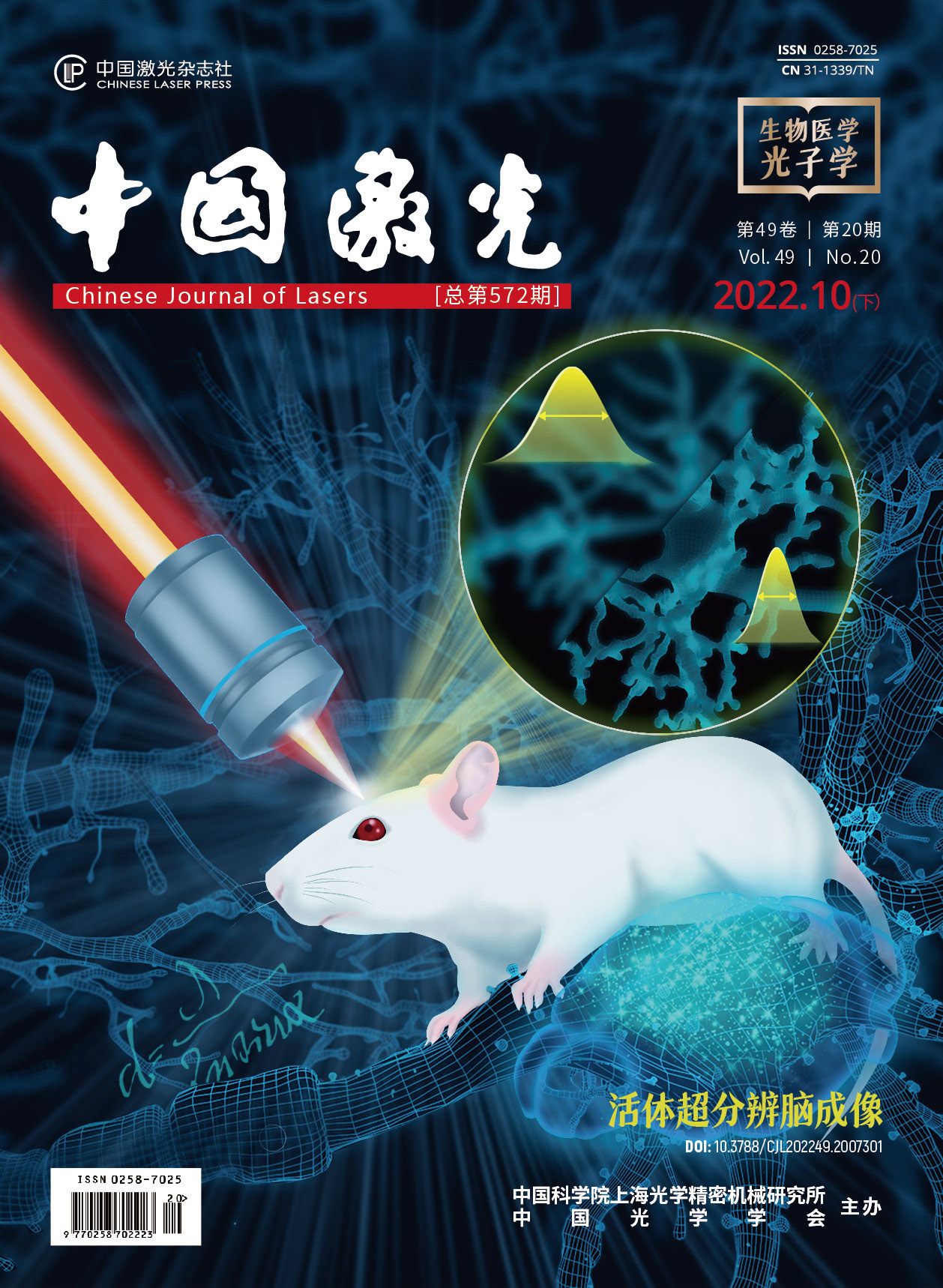光学相干层析成像大纤芯光纤探头的优化研究  下载: 820次
下载: 820次
Developing a fiber probe with a high lateral resolution, long depth of focus, long working distance, and uniform axial light intensity is essential for endoscopic optical coherence tomography (OCT). Traditional beam shaping components, such as axicon lens and binary-phase mask, were minimized and adapted to miniature fiber probes for optimized output beams, but with a short working distance and reduced depth of focus gain compared to their bulk-optic counterparts. Alternatively, pure fiber techniques that simply splice fibers in series were proposed and demonstrated a significant enhancement in the imaging quality. The first demonstration of the concept suggested a phase mask consisting of a short section of overfilled graded-index fiber (Lorenser, 2012). However, the most recent progress indicated that using a step-index large core fiber as a coaxially focused multimode beam generator (Yin, 2017) or a high-efficient fiber-based filter (Ding, 2018) would be advantageous in terms of easy fabrication and increased depth of focus gain. However, full optimization of such probes is not straightforward, where the difficulty originates from the complexity of the light field by multimode interference and the arrangement flexibility of fiber components. Therefore, this study presents systematic research on the optimization of large core fiber probes. We discuss key design considerations for selecting fiber optics for mode excitation, number of modes, beam expansion method, and selecting the lens-free mode or spatial filter mode. We hope that our findings can be essential in designing the ultrathin fiber probe with improved performance for OCT imaging.
A unified equation quantifying the depth of focus gain was first deduced by comparing the Gaussian beam with the same minimal beam diameter. Then, the fiber mode theory was applied to demonstrate the light field manipulated by the large core fiber. The tunning length of the large core fiber was determined by its re-imaging property and modal dispersion. According to the relative position of the large core fiber to the pupil of the objective, the working modes of the probe were classified into two catalogs. Consequently, proximate equations of the output light field were deduced for the two working modes. Then, the optimization goals and restrictions were established in terms of the depth of focus gain, lateral resolution, uniformity of axial light intensity, working distance, and sidelobes. The fast simulation method based on the mode expansion was applied to search for the probe parameters according to the established goals and restrictions. We obtained the preferable structure and the maximum achievable performance of the large-core-fiber-based probe by comparing the optimized results under different working modes, beam expansion methods, and the number of modes. The fiber probe with optimized parameters was fabricated and interfaced to a swept-source OCT system. A conventional probe with the same minimal beam diameter was also fabricated for comparison. The same region of fresh lemon was scanned with a translational stage and imaged by the two probes to confirm whether the improved specifications led to corresponding enhancement in the imaging quality.
Similar to the binary phase filter that regulates the output beam by encoding the phases of annular zones on the aperture, the large core fiber can also adjust modal phases independently for the output beam manipulation. Additionally, the depth of focus, working distance, and lateral resolution are expected to increase with introduced higher modes. Although sidelobes become more significant with increased depth of focus, they can be mitigated by optimizing the modal power distribution. The large-core-fiber-based probe has less stringency on fabrication than the fiber phase mask. With a length tolerance of -28-+ 20 μm (Fig. 8), it is achievable for a commercial off-the-shelf fiber processing platform. The large-core-fiber-based probe features axially uniform light intensity compared with the coaxially focused multimode beam generator (Figs. 10 and 12). For the mode excitation device, we find that the graded-index fiber is superior to the tapered fiber in terms of a more robust splicing point. For the dual-mode interference, the amplitude ratio of the fiber mode can be tuned in the range of 0.2-0.3. For multimode interference, the graded-index fiber can be used with the no core fiber for efficient higher-order mode excitation (Fig. 12). For the working modes of the probe, we conclude that the spatial filter mode is advantageous in a larger depth of focus gain. Additionally, a longer working distance is attainable with beam relay optics (Table 4). The modal dispersion is the ultimate limit on the performance of the large-core-fiber-based probe. We confirmed that the maximum DOF gain of the probe was 3.8.
This study systematically investigates the optimization method of a large-core-fiber-based probe. By comparing the lateral resolution, working distance, and focal depth gain of various probe designs, we believe that the spatial filter design with beam relay optics and higher-order modes is beneficial for the probe performance. In addition to OCT imaging, the principle of the framework can be applied to optimize the output beam in laser scanning and photoacoustic imaging systems. Some presented elements of the work can also provide technical implications for non-imaging applications, such as fabrication of laser-fiber couplers and optical tweezers.
邱建榕, 杨晨, 章程, 孟佳, 韩涛, 钱黄河, 陈沛哲, 杨璐, 刘智毅, 丁志华. 光学相干层析成像大纤芯光纤探头的优化研究[J]. 中国激光, 2022, 49(20): 2007201. Jianrong Qiu, Chen Yang, Cheng Zhang, Jia Meng, Tao Han, Huanghe Qian, Peizhe Chen, Lu Yang, Zhiyi Liu, Zhihua Ding. Optimization of Large-Core-Fiber-Based Fiber Probe for Optical Coherence Tomography[J]. Chinese Journal of Lasers, 2022, 49(20): 2007201.







